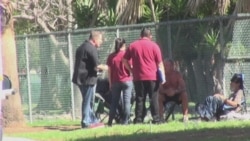Homelessness is up in Los Angeles, where encampments of tents and makeshift shelters line some streets downtown and in the suburbs. Local officials says 25,000 residents are without homes within the city limits. Local officials have declared a war on homelessness, calling it a civic emergency and pledging $100 million for the battle.
Joel John Roberts of the charity People Assisting the Homeless says the festering issue has become a crisis in the past two years. “Homelessness has increased by about 12 to 15 percent,” said Roberts. “The street homelessness or the encampments have increased more than 80 percent.”
Roberts' organization provides interim housing and support services throughout the region.
Homelessness is most visible in a downtown neighborhood called Skid Row. Blocks of streets are lined with tents and shelters, and people sit outside in folding chairs. Police periodically clear the streets to allow for cleaning but – sensitized by lawsuits filed by homeless advocates – they mostly keep a watchful eye on street residents, without interfering.
WATCH: Video report on solutions for the homelessness crisis
The problem of homelessness reaches far beyond the city, and encampments can be seen alongside local freeways and in undeveloped areas on hillsides. In a neighborhood near Los Angeles International Airport, where the houses have been removed for an airport expansion, people live in campers and recreational vehicles along the empty streets.
People like Bernadine Nobbs make the best of a bad situation. She is one of three people who live in a parked van.
“We have running water in there, we have a stove, an oven,” she said. “We can cook. We actually have homemade dinners in there.”
For Nobbs and others like her, rents are just too high. Herb Smith of the Los Angeles Mission, which provides the homeless with shelter, meals, rehabilitation and job training, says the problem is partly economic, as low income residents are priced out of the housing market.
“The pressure of people moving in to get jobs forces [low income] people out,” said Smith. He explained that some of the homeless are at the end of a cycle of bad luck, but others have psychiatric problems or are addicted to alcohol or drugs.
Even those who are back on their feet encounter obstacles. Christian Lofland once was homeless and got assistance and a job through the Los Angeles Mission. He also found an apartment, but he said there were huge hurdles: “credit check, background check, criminal history check, sexual [offender] registry check. Everything that you can imagine.”
Those on the street often have lost their identification, so find it hard to get help from government agencies.
Local officials say the immediate need is for emergency shelters, but those who work with the homeless say remedies must include more affordable housing and other long-term help, from psychiatric services to job training.
The social service agency Chrysalis offers counseling and computers, and lends business clothes to people heading out for job interviews. The organization's president, Mark Loranger, said there are other services, such as storage facilities for personal possessions.
Rows of bins provides safe storage for the belongings of the homeless in a warehouse not far from the main office.
The charity also operates a business that does sanitation work. Employee Miriam Dominguez has spent time in jail, but was able to get a job there doing street cleaning.
“Now I have my own place [apartment],” said Dominguez. “I'm working on getting my car, and most importantly,” she said, “I'm staying out of trouble.”
Those who help the homeless say homelessness has no single cause, and that the solution must also be multifaceted. City officials say short-term remedies include allowing faith groups to open their buildings to the homeless, expanding winter shelters, and taking other measures that have yet to be announced.
Those who live on the streets say they hope the city's recent emergency declaration will finally make a difference.












